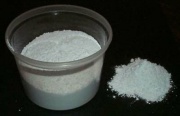Calcium
Description
A soft, white, metallic element. Calcium occurs naturally in the earth's crust at concentrations of 3.64%, which makes it the 5th most abundant element in the earth's crust. The pure material was first isolated by Sir Humphrey Davy in 1808. Calcium is found as salts, such as Calcium carbonate (Limestone, Marble, Chalk, etc) and Calcium sulfate (Gypsum). It is an essential component in plants and animals. As a metal, calcium is harder than Sodium but softer than Aluminum or Magnesium. It tarnishes on exposure to air. Metallic calcium is used in smelting metals as a getter to absorb Oxygen, Carbon dioxide, and [[sulfur dioxide|sulfur] gases.
Synonyms and Related Terms
Ca; calix (Lat.); calcio (It., Esp.); Cálcio (Port.); Kalcium (Sven.)
Other Properties
Flame color is yellow-red. Reacts violently with water, alcohols and dilute acids to evolve hydrogen. Dissolves in ammonium hydroxide to form a blue solution.
| Composition | Ca (atomic no. 20) |
|---|---|
| CAS | 7440-70-2 |
| Melting Point | 850 |
| Density | 1.54 |
| Molecular Weight | atomic wt = 40.078 |
| Boiling Point | 1480 |
Hazards and Safety
Powder ignites in air.
LINK: International Chemical Safety Card
Additional Information
Web Elements: Website
Authority
- G.S.Brady, Materials Handbook, McGraw-Hill Book Co., New York, 1971 Comment: p. 138
- Richard S. Lewis, Hawley's Condensed Chemical Dictionary, Van Nostrand Reinhold, New York, 10th ed., 1993
- Van Nostrand's Scientific Encyclopedia, Douglas M. Considine (ed.), Van Nostrand Reinhold, New York, 1976
- The Merck Index, Martha Windholz (ed.), Merck Research Labs, Rahway NJ, 10th edition, 1983 Comment: entry 1613
- The American Heritage Dictionary or Encarta, via Microsoft Bookshelf 98, Microsoft Corp., 1998
- Chemical & Engineering News, American Chemical Society, Washington DC, 81 (36) , Sept. 8, 2003 Comment: Sture Forsen, p. 66.
